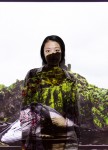Thinking outside the box, Dalena Tran will place her audience inside one, she said.
Tran, a graduate student, said the idea of framing – or putting things into focus – is at the center of her solo art exhibition, titled “mornal : stasis – slowing down a mis-ordering of normal.” The exhibition will be open Tuesday and Wednesday at UCLA’s Broad Art Center. Tran said the concept of framing prevents the audience from just observing art, and instead allows for a relationship between the audience and the installation.
“When things are put into a frame … people are able to contemplate the context of the image very differently,” Tran said. “Because people are forced to look at the things that are emphasized in a frame, whether it be a door, a window or a border, it situates the imagination to confront reality in a specific way.”
Using audiovisuals, her exhibit intends to replicate mundane natural sceneries in a way that makes it feel as if the viewer is actually there, she said. Isla Hansen, an assistant professor in the design media arts program and Tran’s exhibition advisor, said the piece includes projections of animated landscapes. Obvious within the exhibition, these three projections surround the audience in a room. Each one shows a window into an outdoor space, such as a jungle or an ocean. Hansen said Tran’s use of framing also tells the story of how digital media affects humanity.
“I like that this represents what technologies do for us in a society,” Hansen said. “It’s as if this screen that we have on us all the time pulls us into another world technologically, and I can tell that’s what (Tran) is interested in.”
Coupled with the notion of framing is the use of irony, she said. The clashing factors of infinite and definite time appear in the installation in the form of motion, with the audience looking at moving landscapes outside windows. The movements and sounds involved in Tran’s artwork will be in a continuous loop, which Tran said is meant to leave audiences feeling stuck in a never-ending experience.
[RELATED: Upcoming art installation projects shadow of journalistic suppression]
Tran hopes to transform what seem like common experiences by presenting them in ways that change the audience’s perception. She said the audience can interpret it any way it wants, but must be immersed in the space to get the full effect.
“There’s an uncanniness of being able to see adjacent landscapes that you rarely see in the same house, because it’s not often that you look out the window and see a jungle on one side but an ocean on the other,” Hansen said.
Hirad Sab, Tran’s partner and a fellow graduate student at UCLA’s Design Media Arts program, said as a viewer, there is a sense of ambiguity about the piece in terms of its visual language. He said from what Tran sets up for the audience, many will interpret it differently.
“By that virtue, I think it allows the observer to draw their own conclusions,” Sab said. “It really pushes me to think about the human footprints and to analyze whether or not we are as dissociated and disconnected as we think we are from the rest of the environment that we inhabit.”
[RELATED: MFA student exhibition merges STEM, art to explore consciousness through senses]
The installation will be Tran’s first as a graduate student in the design media arts program. It will also be the first time that her work is publicly displayed. Inspired by words on paper, she said she will bring a simulated reality to the audience. She said she wants viewers to see themselves within her work, and specifically within the frames.
“I want for people to be more realizing of how much space they take up when they’re there,” she said. “My idea is that you, as a viewer, go in, and you end up facilitating yourself within the space through the art that replicates a real physical experience.”
